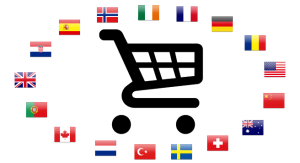2.3 trillion is a big number. It’s also a number that should motivate your business to consider an international e-commerce strategy because 2.3 trillion dollars is the amount that was spent on retail e-commerce around the globe in 2017. That’s an increase of almost 6% over the previous year, and research suggests that the future holds even more good news about global trade in general.
However, before your company can sell goods to many consumers and businesses beyond our borders, you need to assess your readiness to go global. Are your products right for international markets, and if so, how should they be positioned and marketed? Once you have analyzed your potential and researched specific markets, it’s time to get your website up to international speed. Following are five tips for global online readiness:
- Select a Platform that Supports International E-commerce
The storefront you build to sell your goods needs to be global; it should deliver an e-commerce experience that spans countries, with software that allows for customization by language and currency. Some popular global platforms include; Shopify, Magento, PrestaShop, Wix, WooCommerce, and BigCommerce. These e-commerce programs offer multiple storefronts, localized outreach, and personalization.
- Consider the Customer Journey
For all of your customers across countries and regions, your website needs to incorporate functionality that enhances the shopping experience. Responsive websites and secure online payments are now standard expectations among online customers and should be part of your global site and all of your localized storefronts. In addition, with the rise of mobile commerce, a mobile site is critical for the complete customer experience – and the key to your overall global success.
- Prominently Display Shipping Options
One of the primary reasons that online shoppers around the world leave websites without making a purchase? Unexpected shipping costs, according to Barilliance. Your site needs to clearly explain different shipping options, and the cost of each option based on the customer’s global location. Also, consider the end-benefits of free shipping on certain items and during certain time periods (like holidays). It’s critical to keep your international sales on track by avoiding even the perception that you are hiding costs; it also makes an impression on buyers when free shipping is a possibility.
- Offer Live Chat Services
Incorporating live chat support to online shoppers can improve conversion levels by 20 percent, according to a study by Forrester Consulting. Live chat works across languages and allows you to connect with customers when they most need your help. The service keeps shoppers on your site, is easy to use and turns your shoppers into buyers.
- Streamline the Shipping Process for you and your Customers
Advances in shipping, express delivery, and international shipping expertise have been almost as much of a revolution for the global e-commerce boom as the internet itself. Since you are not in the business of transporting your goods, you need a partner who can make it happen easily and seamlessly. Choose an experienced international shipper who can easily integrate service into your global e-commerce store, and watch the results come in.
(Source: How We Made It In Africa)





